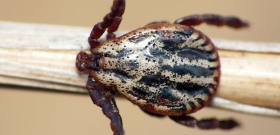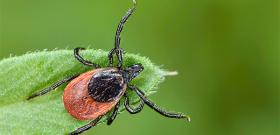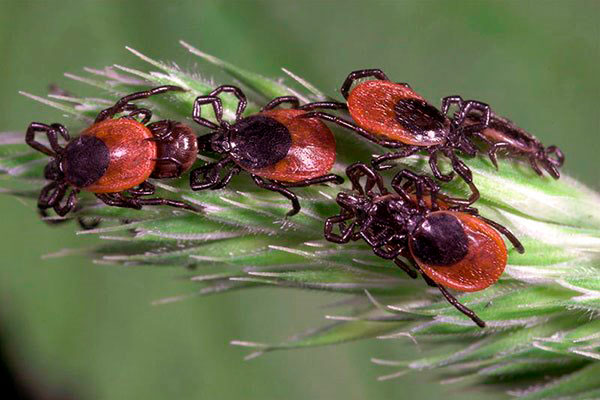
Talk about ixodid ticks usually boils down to a discussion of the harm they cause to humans and the dangers of the infections they carry. But are there creatures that pose a threat to these parasites themselves? Let's talk in detail about who can eat ticks.
In nature, everything is interconnected: all living beings have natural enemies that do not allow their populations to grow uncontrollably. And ticks are no exception. They are an important part of food chains involving a number of insects, birds, frogs, lizards and some other animals.
Before identifying the possible enemies of ticks, let's first consider the appearance and lifestyle of these bloodsuckers.
Appearance and lifestyle of ixodid ticks
Ixodid ticks (Ixodidae) belong to the class of arachnids of the arthropod type. They feed on the blood of people and animals, being their temporary parasites., that is, they spend the main part of their lives in the natural environment, and parasitize only during feeding.
Ticks, like all members of the arachnid class, have eight walking legs. Their body consists of two sections: the head (gnatosomes) and the trunk (idiosomes). The idiosoma is covered with a chitinous cuticle, which, thanks to the folds and furrows that streak it, is able to stretch. This allows the parasite, having sucked blood, to increase in size several times - from 2-4 mm (in a hungry state) to 1 cm (when saturated).
The head of the tick is a complex structure that is firmly fixed in the skin of the victim and does not allow you to easily pull out the attached parasite.
On a note
The oral apparatus of the tick consists of chelicerae, with which, like knives, it cuts through the skin of the host, a proboscis covered with spikes bent towards the base, and pedipalps that perform a tactile function. The spikes of the proboscis, like the hooks of a harpoon, firmly hold it inside the wound, and the saliva continuously secreted by the bloodsucker in some species freezes, forming a very strong structure in the thickness of the skin.
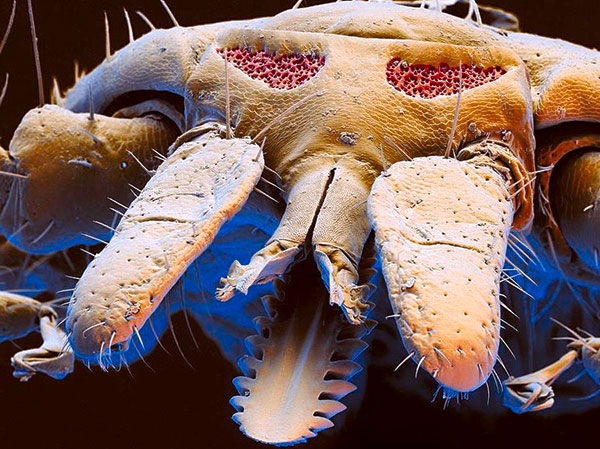
Tick head (macro).
The development cycle of ixodid consists of several stages. The eggs laid by the engorged female hatch into larvae. They live mainly on the ground or crawl into holes, small rodents and birds become their victims. Having sated, the larva molts, turning into a nymph.
Nymphs prey on larger animals; after feeding, they molt into adults. This is the adult stage of ticks, in which they mate, and the females, having fed, lay eggs and then die.
It is interesting
During the life cycle, the parasite usually feeds three times and each time on a new prey - such mites are called three-hosted. There are single-host and two-host species in which all or several stages of development pass on one animal, but this is a rare exception.
Ticks lie in wait for their victims on the ground, in the forest floor, on the tips of blades of grass and branches of bushes. For these arachnids, the presence of high humidity is important, so they do not rise to a height of more than a meter from the surface of the earth.
The parasite freezes in anticipation of prey at the place chosen for lying in wait. When he begins to feel her approach, he becomes active and seeks to crawl onto her.
Usually the bloodsucker waits for the victim to pass by the blade of grass on which he sits, but if contact does not occur, and the prey continues to be felt and is at a distance of several meters, he can get down from his post and crawl towards it.
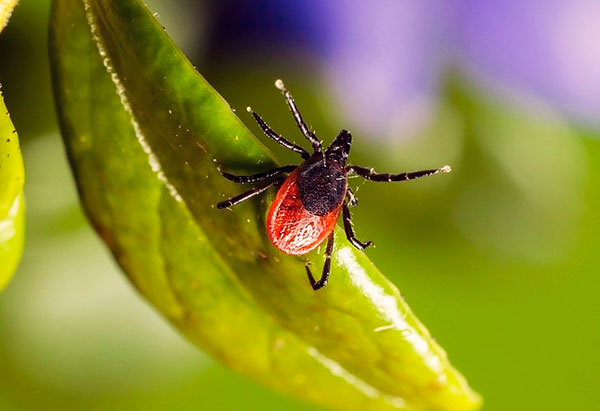
Tick in anticipation of a victim with characteristically elongated front legs.
On a note
On the front legs of the tick are olfactory organs that analyze the composition of the surrounding air. By making oscillatory movements with these paws, the tick better senses the smell of prey passing nearby. In addition to the smell, the tick feels the approach of the victim by the presence of carbon dioxide in the air exhaled by it and the thermal radiation emanating from it.
The tick does not bite its victim right away: for some time it looks for a convenient place on its body where it will be easier for it to get to the blood vessel, and it is more difficult for the victim herself to remove the parasite from herself.
On the host, the tick, having stuck, spends from an hour to several weeks and increases in size several times due to the drunk blood. Then, having fed, the parasite disappears and looks for a secluded place either for molting and transition to the next stage of development, or, if it is an adult female, a place for laying eggs.
Ticks are not active all year round. During periods of winter cold and summer heat, they plunge into a state of diapause, during which all their metabolic processes slow down.
Parasites are most active in spring and late summer - early autumn. They wake up around mid-April, remain active throughout May, disappear in June-July and become active again in August and September. Bloodsuckers fall into hibernation in October-November, when sub-zero temperatures are established.
Much in the behavior of ixodid depends on the climate of a particular region.For example, in places where the summer is hot and dry, ticks will be in diapause during the summer months, but where it is cold and wet, they will retain their activity.
This way of life of ticks suggests that they can either fall prey to any animal that feeds on small arthropods and look for them among the grass, or be accidentally swallowed by herbivores along with plant food. A situation is also possible in which the attached tick will be eaten directly from the host's skin.
Enemies of ixodid among birds
Ticks feed on such birds living in Russia as thrushes, starlings, sparrows, wagtails, chickens, quails, guinea fowls and many others. These birds differ in that they look for their food on the ground: some of them feed on both plant and animal food, others exclusively on animal food, but there are no special species that feed only on ticks. Ticks cannot become victims of such insectivorous birds as, for example, swallows and swifts, as they catch their victims on the fly.
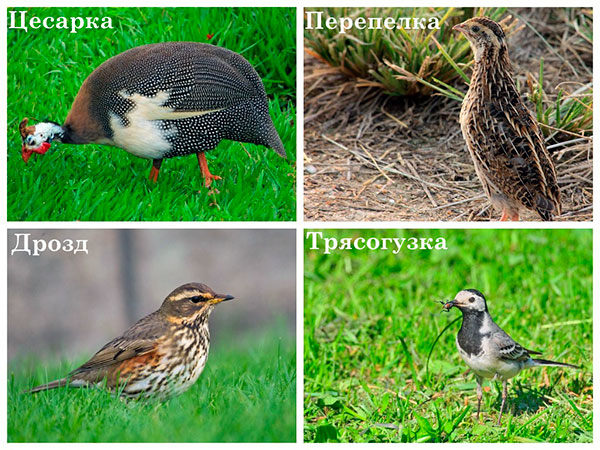
Birds that feed from the ground and may eat ticks.
Moving in the grass, birds look out for insects, spiders and other arthropods, including ticks. Slow parasites become easy prey for them. For birds, large, well-fed ixodids are especially attractive both externally and by smell - most often they become victims of birds. At the same time, a small hungry tick is more difficult to spot, so you should not expect that it is safe in a clearing in a city park, because all the ticks have already been eaten.
Separately, it is necessary to single out birds that eat attached parasites directly from the skin of an animal, being symbiotic cleaners.Examples include oxtails, buffalo weavers, ani cuckoos, and ground finches.
In films about Africa, you can often see shots where a standing or resting buffalo is surrounded by a flock of birds flying over it. These are voloklyui, or buffalo starlings. They live exclusively in Africa, where they are very common.
Voloklui (Buphagus) are small birds of the starling family of the order Passeriformes. Their beak distinguishes them from other representatives of starlings: it is wide, when viewed from the side it looks like an obtuse triangle, and in cross section at the base it is almost round. Depending on the type of starling, it is either yellow-red or red.
The color of the voloklyuev is gray-brown. They have strong legs with curved claws, long wings and a wide, wedge-shaped tail.
These birds spend all the time near grazing herbivores: buffaloes, rhinos, giraffes, zebras, antelopes, from the skin of which they peck out their main food: ticks, lice and gadfly larvae.
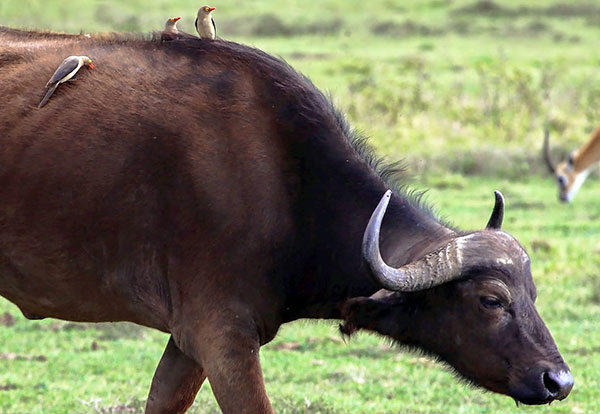
Voloklui peck out various insects, including ticks, from the wool of large artiodactyls.
It is interesting
Voloklyuev cannot be called good helpers: eating parasites, they scratch the animal's skin and drink its blood. At the same time, an infection gets into the resulting wounds from the claws and beak of birds.
Buffalo weavers (Bubalornis) from the weaver family behave in a similar way. They also live in Africa and eat ticks and insects from the skin of buffaloes and other large herbivores. In India, white herons have been seen doing a similar thing.
In North and South America live ani (Crotophaga ani) - birds of the cuckoo family. They are found in meadows, in the bush and in forest clearings. These birds have a large head and a large blunt beak, plumage is black, body length is about 35 cm.
Birds of this species do not fly well and mainly spend their lives on the ground, preying on insects, lizards and frogs, and also sit on cattle and peck ticks from their wool.
It is interesting
Anis live in groups, and several females lay eggs in their large nests at once. They take turns incubating the common masonry and feeding the chicks together.
The Galapagos Islands are inhabited by medium and small ground finches. They feed on seeds, flowers, leaves and fruits. In addition, these species of finches enter into symbiotic relationships with elephant tortoise, Galapagos conolophos and marine iguana, eating parasites from their skin.
Insect hunters for bloodsuckers
Ixodids can also fall prey to any predatory invertebrate. Ticks are eaten by ants, ground beetles, lacewings, dragonflies, bedbugs, spiders, predatory centipedes and other arthropods. In addition, these bloodsuckers themselves can be attacked by other parasites: wasps and ichneumons.
Ground beetles (Carabidae) are a large family of flightless predatory beetles that live in almost all latitudes - from the tundra to tropical forests and deserts. They actively move in search of prey, and any invertebrates that they can catch become their victims: insects, worms, molluscs, and also ticks.

The ground beetle is a carnivorous beetle. It feeds on many insects, including mites.
Lacewings (Chrysopidae) are a family of graceful insects of the lacewing order. They feed on pollen and nectar of flowers, but their larvae are aggressive predators that actively eat aphids, mites, mealybugs and other small arthropods.
Active enemies of ixodid ticks and clutches of their eggs are ants, for which the engorged tick is a tasty prey.In addition, the smell of formic acid repels parasites, and they avoid being near anthills.
Among insects that feed on mites, ichneumons and parasitic wasps stand apart. Their peculiarity is that they do not eat their victims themselves, but lay eggs inside their bodies. The hatched larvae from the inside devour their host alive.
Parasitic wasps paralyze their prey with poison and hide in nests, laying eggs in it. And the victims of ichneumons continue to lead a normal life until the larvae of the parasite grow up and leave their body to pupate. After that, the emaciated host dies.
Ixodiphagus hookeri is known among ichneumons parasitizing on ixodid ticks. This species lives all over the world, except for Antarctica, and parasitizes ticks of the genera Ixodes, Dermacentor, Rhipicephalus, Haemaphysalis, Hyalomma, Ornithodoros and Amblyomma. Its most frequent victim is the dog tick Ixodes ricinus, but it does not attack the meadow tick (Dermacentor reticulatus).
This rider lays eggs in hungry nymphs, and its larvae hatch after the infected arachnid is fed. They parasitize in the tick from 28 to 70 days.
There are special parasites - egg-eaters, which lay their eggs in the eggs of other arthropods, including tick eggs, piercing them with a thin ovipositor. The developing larva eats the insides of another egg.
What terrestrial vertebrates eat ticks
Ticks often fall prey to small lizards, toads and frogs, which prefer places as warm and humid as the bloodsuckers themselves. Night insect hunters - hedgehogs - also do not disdain a parasite that gets in the way.

The hedgehog forages mainly at night.Sometimes it can also eat ticks.
Among the mammals whose prey are ticks, mongooses can be noted. In Uganda's Queen Elizabeth National Park, warthogs have been observed to lie down on the ground when they meet mongooses, allowing these animals to collect insects and mites from their skins and eat them.
Ticks are also eaten by grooming animals, such as monkeys. These animals clean and sort out each other's hair, pulling out and eating attached parasites. This procedure consists not so much in cleaning, but in tactile communication of individuals.
It is interesting
In addition to animals, some fungi can also feed on ticks. For example, representatives of the genus Aspergillus (Aspergillus), penetrating into the tissues of the arachnid and developing there, release toxins and block the circulation of hemolymph. All this leads to the death of the tick.
Fungi of the genera Hirsutella, Hymenostilbe, Synnematium infect insects, spiders and mites. A feature of these fungi is the formation of long outgrowths on the body of infected arthropods - coremia. They are cylindrical or club-shaped and grow from various parts of the host's body or are scattered over its entire surface in the form of small tubercles.
A situation is possible when a tick is accidentally eaten by a domestic or wild herbivore along with the plant on which it was located.
If a bloodsucker eaten by a cow or goat was infected with the tick-borne encephalitis virus, then there is a danger for a person to get this disease by drinking milk that has not undergone heat treatment.
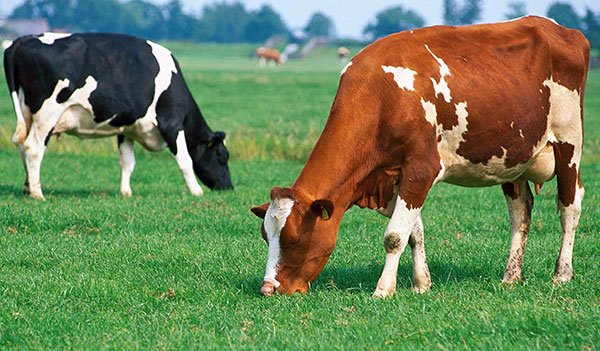
Human infection with tick-borne encephalitis can occur through milk if the cow ate the encephalitis parasite along with the grass.
On a note
Tick-borne encephalitis is an extremely dangerous viral disease transmitted by ixodids. In humans, it causes serious damage to the brain and nervous system as a whole, leading to disability and often death.
In nature, this virus is present in the blood of many wild animals. With the participation of ticks, it circulates and spreads in their populations. However, the animals themselves do not suffer from encephalitis. Thus, if a bird eats an "encephalitic" tick, it will not be affected in any way, but it will also become a carrier of the virus.
There are practically no specific creatures that feed exclusively on ticks (except for a certain type of riders). Ticks are included in the diet of many living organisms, but are not an obligatory food product for them.
On the territory of Russia, the main enemies of ticks are insectivorous birds and terrestrial animals, as well as predatory insects. Voloklui and mongooses, although they are of interest in terms of combating bloodsuckers, are not found in our country.
Ground beetles, ichneumons, ants and lacewing larvae control the parasite population by destroying them and their egg clutches. The massive use of such toxic substances as, for example, DDT for the treatment of forests in Soviet times, led to the destruction of not only ticks, but also their natural enemies. Thus, new generations of bloodsuckers could no longer be afraid of being eaten, and their populations multiplied uncontrollably.
Burning grass carries the same danger: not only pests, but also beneficial insects, rodents, birds nesting on the ground and many other small animals die in the fire.
Despite the fact that the natural enemies of ticks mentioned above prefer to hunt already fed individuals and do not make forests, glades and meadows completely safe for human recreation, they reduce the possible growth of the bloodsucking population, because each female is able to lay several thousand eggs.
That is why it is very important not to rudely interfere in natural processes, since the destruction of one of the links in the food chain can be fatal for many species of living beings.
On the possibilities of attack by ticks and the mechanisms of parasite bite
The nature of the relationship between ticks and ants: interesting experiments


